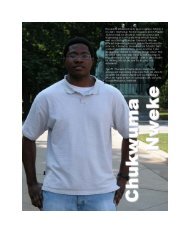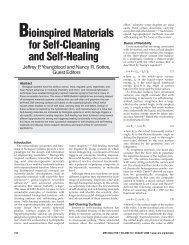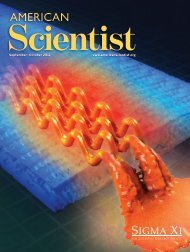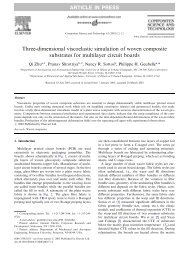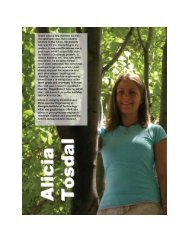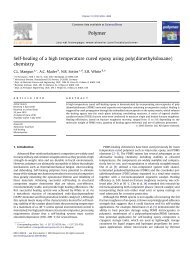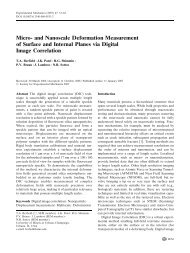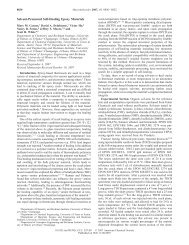Effect of microcapsule size on the performance of self-healing ...
Effect of microcapsule size on the performance of self-healing ...
Effect of microcapsule size on the performance of self-healing ...
You also want an ePaper? Increase the reach of your titles
YUMPU automatically turns print PDFs into web optimized ePapers that Google loves.
J.D. Rule et al. / Polymer 48 (2007) 3520e3529<br />
3523<br />
Fig. 3. Fracture test results in terms <str<strong>on</strong>g>of</str<strong>on</strong>g> both (a) strain energy-to-failure and (b)<br />
peak load for <strong>self</strong>-healed TDCB specimens with varying <str<strong>on</strong>g>microcapsule</str<strong>on</strong>g> <str<strong>on</strong>g>size</str<strong>on</strong>g>s<br />
and weight fracti<strong>on</strong>s.<br />
While Fig. 3 shows <strong>the</strong> <strong>self</strong>-<strong>healing</strong> <strong>performance</strong> as a functi<strong>on</strong><br />
<str<strong>on</strong>g>of</str<strong>on</strong>g> <str<strong>on</strong>g>microcapsule</str<strong>on</strong>g> weight fracti<strong>on</strong>, Fig. 4 shows <strong>the</strong> <strong>healing</strong><br />
<strong>performance</strong> (for <strong>the</strong> same set <str<strong>on</strong>g>of</str<strong>on</strong>g> experiments) as a functi<strong>on</strong> <str<strong>on</strong>g>of</str<strong>on</strong>g><br />
<strong>the</strong> <strong>the</strong>oretical amount <str<strong>on</strong>g>of</str<strong>on</strong>g> available <strong>healing</strong> agent per unit<br />
crack area as calculated by Eq. (5). In this case, <strong>the</strong> x-axis<br />
value is determined by <strong>the</strong> product <str<strong>on</strong>g>of</str<strong>on</strong>g> <strong>the</strong> <str<strong>on</strong>g>microcapsule</str<strong>on</strong>g> <str<strong>on</strong>g>size</str<strong>on</strong>g><br />
and <strong>the</strong> <str<strong>on</strong>g>microcapsule</str<strong>on</strong>g> weight fracti<strong>on</strong>. The figure also shows<br />
data for experiments where <strong>the</strong> DCPD <strong>healing</strong> agent was<br />
delivered by manual injecti<strong>on</strong> instead <str<strong>on</strong>g>of</str<strong>on</strong>g> by <str<strong>on</strong>g>microcapsule</str<strong>on</strong>g>s<br />
(vide infra). Compared to Fig. 3, <strong>the</strong> data in Fig. 4 are grouped<br />
toge<strong>the</strong>r more str<strong>on</strong>gly, especially when <strong>the</strong> <str<strong>on</strong>g>microcapsule</str<strong>on</strong>g><br />
weight fracti<strong>on</strong> is less than 20 wt%. These results suggest<br />
that <strong>the</strong> observed <strong>healing</strong> <strong>performance</strong> in this system is largely<br />
coupled to <strong>the</strong> product <str<strong>on</strong>g>of</str<strong>on</strong>g> <str<strong>on</strong>g>microcapsule</str<strong>on</strong>g> <str<strong>on</strong>g>size</str<strong>on</strong>g> and <str<strong>on</strong>g>microcapsule</str<strong>on</strong>g><br />
weight fracti<strong>on</strong>. Assuming that <strong>self</strong>-<strong>healing</strong> <strong>performance</strong><br />
depends <strong>on</strong> <strong>the</strong> amount <str<strong>on</strong>g>of</str<strong>on</strong>g> available <strong>healing</strong> agent, <strong>the</strong>se data<br />
support <strong>the</strong> validity <str<strong>on</strong>g>of</str<strong>on</strong>g> Eq. (5). The excepti<strong>on</strong> is when high<br />
weight fracti<strong>on</strong>s (20%) <str<strong>on</strong>g>of</str<strong>on</strong>g> <strong>healing</strong> agent are used. The relatively<br />
lower <strong>performance</strong> observed with 20 wt% <str<strong>on</strong>g>microcapsule</str<strong>on</strong>g>s was<br />
repeatable over a large number <str<strong>on</strong>g>of</str<strong>on</strong>g> samples, but <strong>the</strong> exact<br />
reas<strong>on</strong> for <strong>the</strong> deviati<strong>on</strong> is not clear.<br />
The average volume <str<strong>on</strong>g>of</str<strong>on</strong>g> <strong>the</strong> crack in <strong>the</strong> fractured TDCB<br />
specimens was examined by light microscopy to determine<br />
how <strong>the</strong> amount <str<strong>on</strong>g>of</str<strong>on</strong>g> required <strong>healing</strong> agent relates to <strong>the</strong> volume<br />
<str<strong>on</strong>g>of</str<strong>on</strong>g> <strong>the</strong> crack that is being repaired. The average crack<br />
face separati<strong>on</strong> is 26 mm (standard deviati<strong>on</strong> ¼ 7 mm) near<br />
<strong>the</strong> top <str<strong>on</strong>g>of</str<strong>on</strong>g> <strong>the</strong> fractured sample (i.e. closest to <strong>the</strong> pin-loading<br />
holes, Fig. 5a) and 8 mm (standard deviati<strong>on</strong> ¼ 3 mm) near <strong>the</strong><br />
bottom <str<strong>on</strong>g>of</str<strong>on</strong>g> <strong>the</strong> sample. With a crack face separati<strong>on</strong> <str<strong>on</strong>g>of</str<strong>on</strong>g> 26 mm,<br />
<strong>the</strong> crack volume is 2.6 mL/cm 2 <str<strong>on</strong>g>of</str<strong>on</strong>g> crack area. Thus, it would<br />
be expected that a <strong>healing</strong> agent delivery <str<strong>on</strong>g>of</str<strong>on</strong>g> at least<br />
2.6 mg/cm 2 would be needed to completely fill this crack<br />
and give maximum <strong>self</strong>-<strong>healing</strong> (density <str<strong>on</strong>g>of</str<strong>on</strong>g> DCPD ¼<br />
0.98 g/cm 3 ). Not surprisingly, Fig. 4 shows that <strong>healing</strong> <strong>performance</strong><br />
declines rapidly when <strong>healing</strong> agent delivery is less<br />
than 2.6 mg/cm 2 .<br />
The experimental data in Fig. 3 dem<strong>on</strong>strate that at a given<br />
weight fracti<strong>on</strong>, larger <str<strong>on</strong>g>microcapsule</str<strong>on</strong>g>s produce superior <strong>healing</strong><br />
<strong>performance</strong>, and <strong>the</strong>ory suggests that this increased <strong>performance</strong><br />
is due to <strong>the</strong> delivery <str<strong>on</strong>g>of</str<strong>on</strong>g> more <strong>healing</strong> agent per unit<br />
crack area. SEM images <str<strong>on</strong>g>of</str<strong>on</strong>g> fracture surfaces fur<strong>the</strong>r c<strong>on</strong>firm<br />
that <strong>the</strong> increase in <strong>healing</strong> <strong>performance</strong> from <strong>the</strong> larger capsules<br />
is due to delivery <str<strong>on</strong>g>of</str<strong>on</strong>g> greater amounts <str<strong>on</strong>g>of</str<strong>on</strong>g> <strong>healing</strong> agent.<br />
Fig. 6a shows a representative crack plane from a specimen<br />
with 20 wt% <str<strong>on</strong>g>of</str<strong>on</strong>g> 63 mm <str<strong>on</strong>g>microcapsule</str<strong>on</strong>g>s after being fractured,<br />
healed, and fractured again. Patches <str<strong>on</strong>g>of</str<strong>on</strong>g> polymerized DCPD<br />
are present <strong>on</strong> <strong>the</strong> fracture surface, but <strong>the</strong> coverage is incomplete.<br />
Fig. 6b is an analogous image from a specimen with<br />
10 wt% <str<strong>on</strong>g>of</str<strong>on</strong>g> 386 mm <str<strong>on</strong>g>microcapsule</str<strong>on</strong>g>s. Despite having a lower<br />
weight fracti<strong>on</strong> <str<strong>on</strong>g>of</str<strong>on</strong>g> <str<strong>on</strong>g>microcapsule</str<strong>on</strong>g>s present, <strong>the</strong> coverage <str<strong>on</strong>g>of</str<strong>on</strong>g><br />
polymerized DCPD is now nearly complete over <strong>the</strong> entire<br />
crack plane.<br />
The data in Figs. 3 and 4 indicate that <strong>the</strong> product <str<strong>on</strong>g>of</str<strong>on</strong>g> <str<strong>on</strong>g>microcapsule</str<strong>on</strong>g><br />
<str<strong>on</strong>g>size</str<strong>on</strong>g> and weight fracti<strong>on</strong> c<strong>on</strong>trols both <strong>the</strong> amount <str<strong>on</strong>g>of</str<strong>on</strong>g><br />
<strong>healing</strong> agent available in <strong>the</strong> crack plane and <strong>the</strong> level <str<strong>on</strong>g>of</str<strong>on</strong>g><br />
<strong>self</strong>-<strong>healing</strong> that is achieved. However, <strong>the</strong>se data al<strong>on</strong>e cannot<br />
c<strong>on</strong>firm that <strong>the</strong> calculated amounts <str<strong>on</strong>g>of</str<strong>on</strong>g> <strong>healing</strong> agent delivery<br />
are quantitatively accurate. Therefore, fur<strong>the</strong>r tests were performed<br />
with TDCB specimens c<strong>on</strong>taining catalyst, but not<br />
DCPD <str<strong>on</strong>g>microcapsule</str<strong>on</strong>g>s. These specimens were fractured and<br />
<strong>the</strong>n measured amounts <str<strong>on</strong>g>of</str<strong>on</strong>g> <strong>healing</strong> agent were manually delivered<br />
to <strong>the</strong> crack plane using a syringe. The two halves <str<strong>on</strong>g>of</str<strong>on</strong>g> each<br />
fractured specimen were <strong>the</strong>n rejoined and held in c<strong>on</strong>tact for<br />
24 h before retesting. These experiments are analogous to <strong>the</strong><br />
<strong>self</strong>-<strong>healing</strong> tests, but <strong>the</strong>y differ in that <strong>the</strong> amount <str<strong>on</strong>g>of</str<strong>on</strong>g> <strong>healing</strong><br />
agent <strong>on</strong> <strong>the</strong> crack plane is explicitly known and is manually<br />
applied.<br />
The results <str<strong>on</strong>g>of</str<strong>on</strong>g> <strong>the</strong> tests with manually injected <strong>healing</strong><br />
agent are shown in Fig. 4 toge<strong>the</strong>r with <strong>the</strong> data from <strong>self</strong><strong>healing</strong><br />
specimens in which <strong>the</strong> <strong>healing</strong> agent is delivered<br />
aut<strong>on</strong>omically via <str<strong>on</strong>g>microcapsule</str<strong>on</strong>g>s. The data for <strong>the</strong> manually<br />
injected <strong>healing</strong> agent follow nearly <strong>the</strong> same trend as <strong>the</strong><br />
data in which <str<strong>on</strong>g>microcapsule</str<strong>on</strong>g>s are used for <strong>healing</strong> agent delivery.<br />
The agreement <str<strong>on</strong>g>of</str<strong>on</strong>g> <strong>the</strong>se results indicates that <strong>the</strong> calculati<strong>on</strong>s<br />
<str<strong>on</strong>g>of</str<strong>on</strong>g> <strong>healing</strong> agent delivery using Eq. (5) are reas<strong>on</strong>ably<br />
accurate.





